dashboard Peugeot 3008 Hybrid 4 2017 Owner's Manual - RHD (UK. Australia)
[x] Cancel search | Manufacturer: PEUGEOT, Model Year: 2017, Model line: 3008 Hybrid 4, Model: Peugeot 3008 Hybrid 4 2017Pages: 578, PDF Size: 16.41 MB
Page 19 of 578
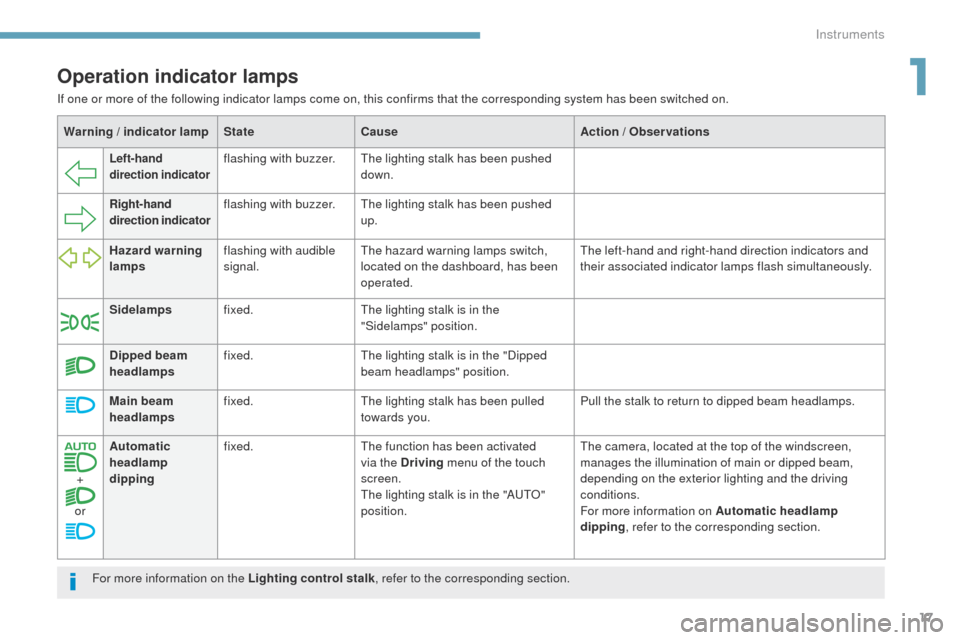
17
3008-2_en_Chap01_instruments-de-bord_ed01-2016
Warning / indicator lampStateCause Action / Observations
Left-hand
direction indicatorflashing with buzzer.The lighting stalk has been pushed
down.
Right-hand
direction indicator flashing with buzzer.
The lighting stalk has been pushed
up.
Hazard warning
lamps flashing with audible
signal. The hazard warning lamps switch,
located on the dashboard, has been
operated. The left-hand and right-hand direction indicators and
their associated indicator lamps flash simultaneously.
Sidelamps fixed. The lighting stalk is in the
"Sidelamps" position.
Dipped beam
headlamps fixed.
The lighting stalk is in the "Dipped
beam headlamps" position.
Main beam
headlamps fixed.
The lighting stalk has been pulled
towards you. Pull the stalk to return to dipped beam headlamps.
+
or Automatic
headlamp
dipping
fixed.
The function has been activated
via the Driving menu of the touch
screen.
The lighting stalk is in the "AUTO"
position. The camera, located at the top of the windscreen,
manages the illumination of main or dipped beam,
depending on the exterior lighting and the driving
conditions.
For more information on Automatic headlamp
dipping
, refer to the corresponding section.
Operation indicator lamps
For more information on the Lighting control stalk , refer to the corresponding section.
If one or more of the following indicator lamps come on, this confirms that the corresponding system has been switched on.
1
Instruments
Page 58 of 578

56
3008-2_en_Chap02_ouvertures_ed01-2016
Deadlocking
F Make a first press on this button.
F W ithin five seconds, press this
button again to deadlock the
vehicle.
Deadlocking renders the interior door
controls inoperative.
It also deactivates the interior central
locking button on the dashboard.
Therefore, never leave anyone inside
the vehicle when it is deadlocked.
Locating your vehicle
F Press this button.
This will switch on the courtesy lamps and door
mirror spot lamps and the direction indicators
will flash for around ten seconds. This function allows you to identify your vehicle
from a distance, particularly in poor light. Your
vehicle must be locked.
For versions without alarm, deadlocking is
confirmed by illumination of the direction
indicators for few seconds on the second press
of the locking button. Closing the windows and sunroof
Pressing and holding the locking
button closes the windows and,
depending on version, the sunroof to
the desired position.
When closing the windows and sunroof
you must ensure that nothing prevents
their correct closing.
If, on versions with alarm, you want to
leave the windows and/or sunroof partly
open, you must first deactivate the
volumetric alarm protection.
For more information on the Alarm ,
refer to the corresponding section.
This operation also starts closing of the blind.
Access
Page 64 of 578

62
3008-2_en_Chap02_ouvertures_ed01-2016
Accumulations (water, dust, grime,
salt...) on the inner sur face of the door
handle may affect detection.
If cleaning the inner sur face of the door
handle using a cloth does not restore
detection, contact a PEUGEOT dealer
or a qualified workshop.
A sudden splash of water (stream of
water, high pressure jet washer, …)
may be identified by the system as the
desire to open the vehicle.
DeadlockingF With the electronic key in the recognition zone A , press a finger or thumb on one of
the front door handles (at the markings)
or on the locking control located on the
tailgate (to the right).
F
W
ithin five seconds, press one of these
locking controls again to deadlock the
vehicle. At the first press on one of the locking controls,
illumination of the direction indicators for a few
seconds signals:
-
t
he locking of the vehicle for versions
without alarm,
-
t
he activation of the alarm for other
versions.
Depending on version, the door mirrors fold.
At the second press, illumination of the
direction indicators for a few seconds signals
the deadlocking of the vehicle for versions
without alarm.
Deadlocking renders the interior door
controls inoperative.
It also deactivates the interior central
control button on the dashboard.
Therefore, never leave anyone inside
the vehicle when it is deadlocked.
Access
Page 79 of 578
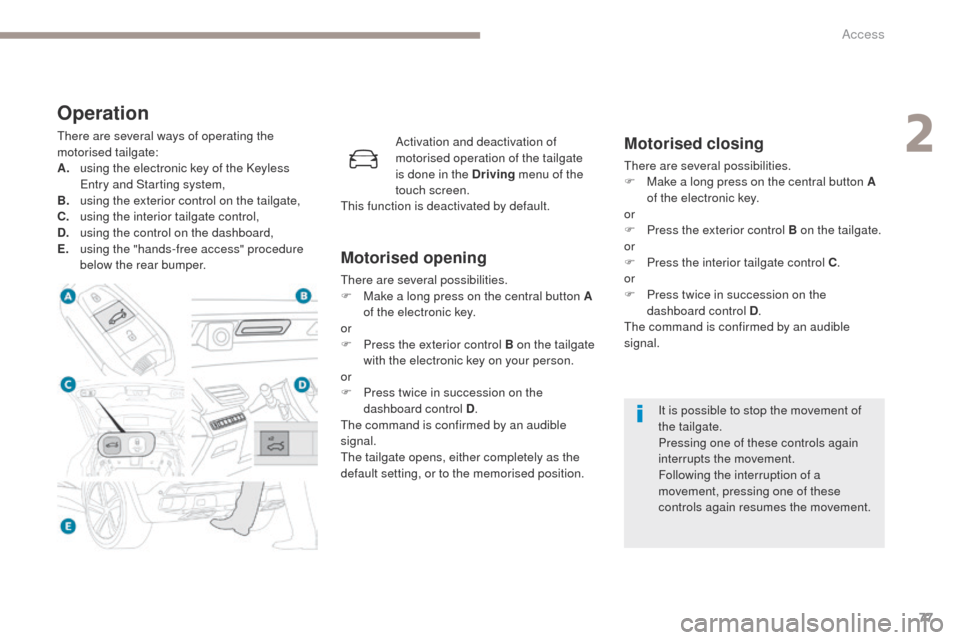
77
3008-2_en_Chap02_ouvertures_ed01-2016
Operation
There are several ways of operating the
motorised tailgate:
A.
u
sing the electronic key of the Keyless
Entry and Starting system,
B.
u
sing the exterior control on the tailgate,
C.
u
sing the interior tailgate control,
D.
u
sing the control on the dashboard,
E.
u
sing the "hands-free access" procedure
below the rear bumper.
Motorised opening
There are several possibilities.
F M ake a long press on the central button A
of the electronic key.
or
F
P
ress the exterior control B on the tailgate
with the electronic key on your person.
or
F
P
ress twice in succession on the
dashboard control D .
The command is confirmed by an audible
signal.
The tailgate opens, either completely as the
default setting, or to the memorised position.
Motorised closing
There are several possibilities.
F M ake a long press on the central button A
of the electronic key.
or
F
P
ress the exterior control B on the tailgate.
or
F
P
ress the interior tailgate control C .
or
F
P
ress twice in succession on the
dashboard control D .
The command is confirmed by an audible
signal.
Activation and deactivation of
motorised operation of the tailgate
is done in the Driving
menu of the
touch screen.
This function is deactivated by default.
It is possible to stop the movement of
the tailgate.
Pressing one of these controls again
interrupts the movement.
Following the interruption of a
movement, pressing one of these
controls again resumes the movement.
2
Access
Page 90 of 578
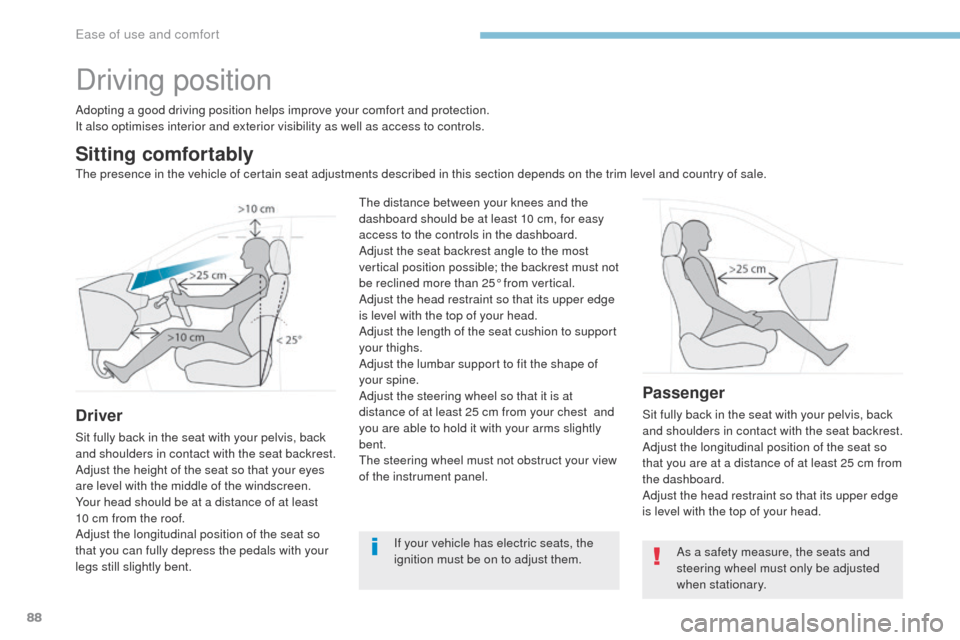
88
3008-2_en_Chap03_ergonomie-et-confort_ed01-2016
Driving position
Adopting a good driving position helps improve your comfort and protection.
It also optimises interior and exterior visibility as well as access to controls.
Sitting comfortably
Driver
Sit fully back in the seat with your pelvis, back
and shoulders in contact with the seat backrest.
Adjust the height of the seat so that your eyes
are level with the middle of the windscreen.
Your head should be at a distance of at least
10 cm from the roof.
Adjust the longitudinal position of the seat so
that you can fully depress the pedals with your
legs still slightly bent.
Passenger
Sit fully back in the seat with your pelvis, back
and shoulders in contact with the seat backrest.
Adjust the longitudinal position of the seat so
that you are at a distance of at least 25 cm from
the dashboard.
Adjust the head restraint so that its upper edge
is level with the top of your head.
If your vehicle has electric seats, the
ignition must be on to adjust them.
The distance between your knees and the
dashboard should be at least 10 cm, for easy
access to the controls in the dashboard.
Adjust the seat backrest angle to the most
vertical position possible; the backrest must not
be reclined more than 25° from vertical.
Adjust the head restraint so that its upper edge
is level with the top of your head.
Adjust the length of the seat cushion to support
your thighs.
Adjust the lumbar support to fit the shape of
your spine.
Adjust the steering wheel so that it is at
distance of at least 25 cm from your chest
and
you are able to hold it with your arms slightly
bent.
The steering wheel must not obstruct your view
of the instrument panel.
As a safety measure, the seats and
steering wheel must only be adjusted
when stationary.
The presence in the vehicle of certain seat adjustments described in this section depends on the trim level and country of sale.
Ease of use and comfort
Page 106 of 578
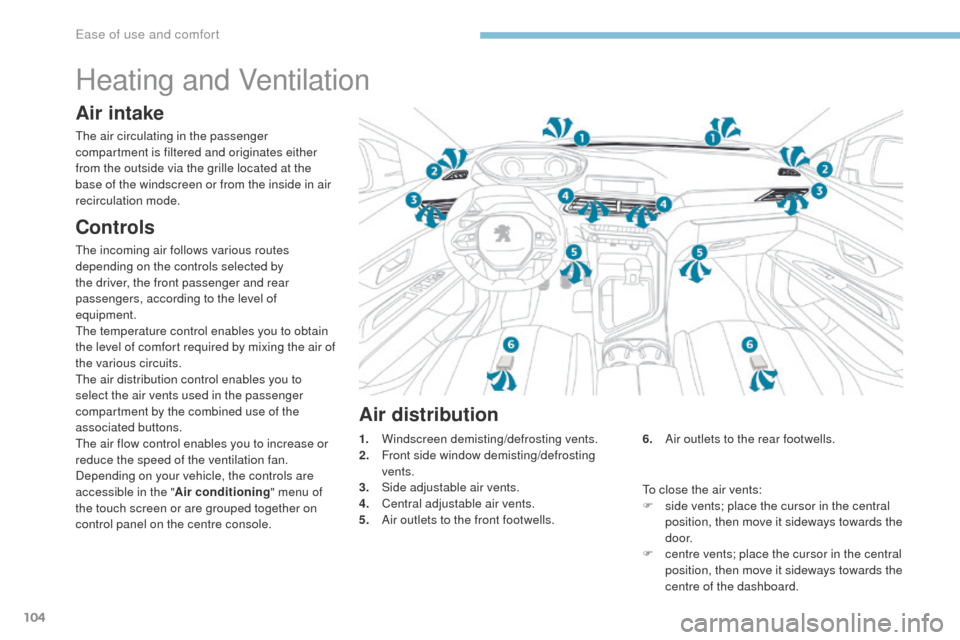
104
3008-2_en_Chap03_ergonomie-et-confort_ed01-2016
Heating and Ventilation
Air intake
The air circulating in the passenger
compartment is filtered and originates either
from the outside via the grille located at the
base of the windscreen or from the inside in air
recirculation mode.
Controls
The incoming air follows various routes
depending on the controls selected by
the driver, the front passenger and rear
passengers, according to the level of
equipment.
The temperature control enables you to obtain
the level of comfort required by mixing the air of
the various circuits.
The air distribution control enables you to
select the air vents used in the passenger
compartment by the combined use of the
associated buttons.
The air flow control enables you to increase or
reduce the speed of the ventilation fan.
Depending on your vehicle, the controls are
accessible in the "Air conditioning" menu of
the touch screen or are grouped together on
control panel on the centre console.
Air distribution
1. Windscreen demisting/defrosting vents.
2. F ront side window demisting/defrosting
vents.
3.
S
ide adjustable air vents.
4.
C
entral adjustable air vents.
5.
A
ir outlets to the front footwells. 6. A
ir outlets to the rear footwells.
To close the air vents:
F
s
ide vents; place the cursor in the central
position, then move it sideways towards the
d o o r.
F
c
entre vents; place the cursor in the central
position, then move it sideways towards the
centre of the dashboard.
Ease of use and comfort
Page 107 of 578
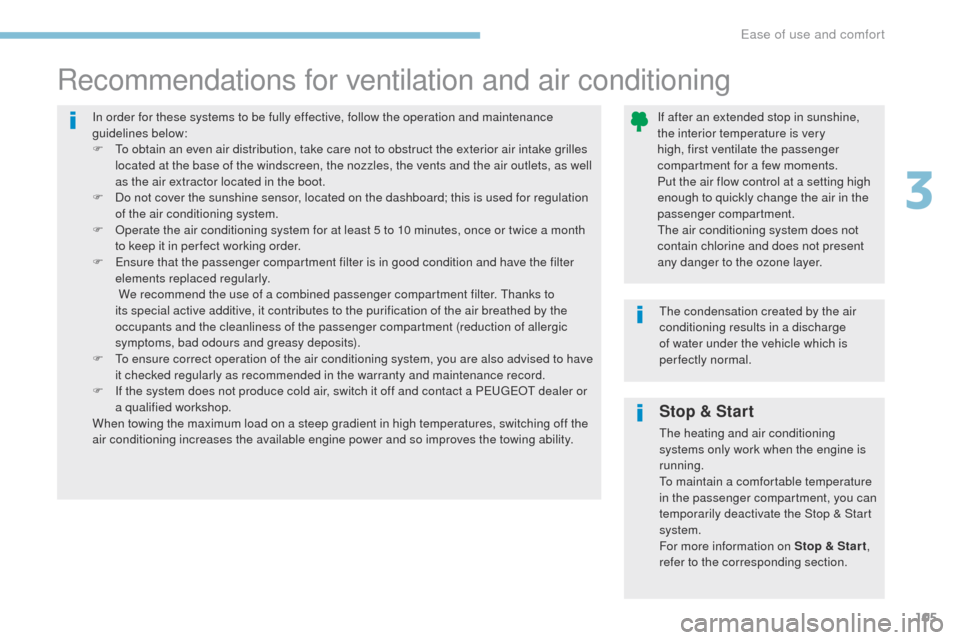
105
3008-2_en_Chap03_ergonomie-et-confort_ed01-2016
Stop & Start
The heating and air conditioning
systems only work when the engine is
running.
To maintain a comfortable temperature
in the passenger compartment, you can
temporarily deactivate the Stop & Start
system.
For more information on Stop & Star t,
refer to the corresponding section.
In order for these systems to be fully effective, follow the operation and maintenance
guidelines below:
F
T
o obtain an even air distribution, take care not to obstruct the exterior air intake grilles
located at the base of the windscreen, the nozzles, the vents and the air outlets, as well
as the air extractor located in the boot.
F
D
o not cover the sunshine sensor, located on the dashboard; this is used for regulation
of the air conditioning system.
F
O
perate the air conditioning system for at least 5 to 10 minutes, once or twice a month
to keep it in per fect working order.
F
E
nsure that the passenger compartment filter is in good condition and have the filter
elements replaced regularly.
W
e recommend the use of a combined passenger compartment filter. Thanks to
its special active additive, it contributes to the purification of the air breathed by the
occupants and the cleanliness of the passenger compartment (reduction of allergic
symptoms, bad odours and greasy deposits).
F
T
o ensure correct operation of the air conditioning system, you are also advised to have
it checked regularly as recommended in the warranty and maintenance record.
F
I
f the system does not produce cold air, switch it off and contact a PEUGEOT dealer or
a qualified workshop.
When towing the maximum load on a steep gradient in high temperatures, switching off the
air conditioning increases the available engine power and so improves the towing ability. The condensation created by the air
conditioning results in a discharge
of water under the vehicle which is
perfectly normal.
If after an extended stop in sunshine,
the interior temperature is very
high, first ventilate the passenger
compartment for a few moments.
Put the air flow control at a setting high
enough to quickly change the air in the
passenger compartment.
The air conditioning system does not
contain chlorine and does not present
any danger to the ozone layer.
Recommendations for ventilation and air conditioning
3
Ease of use and comfort
Page 159 of 578
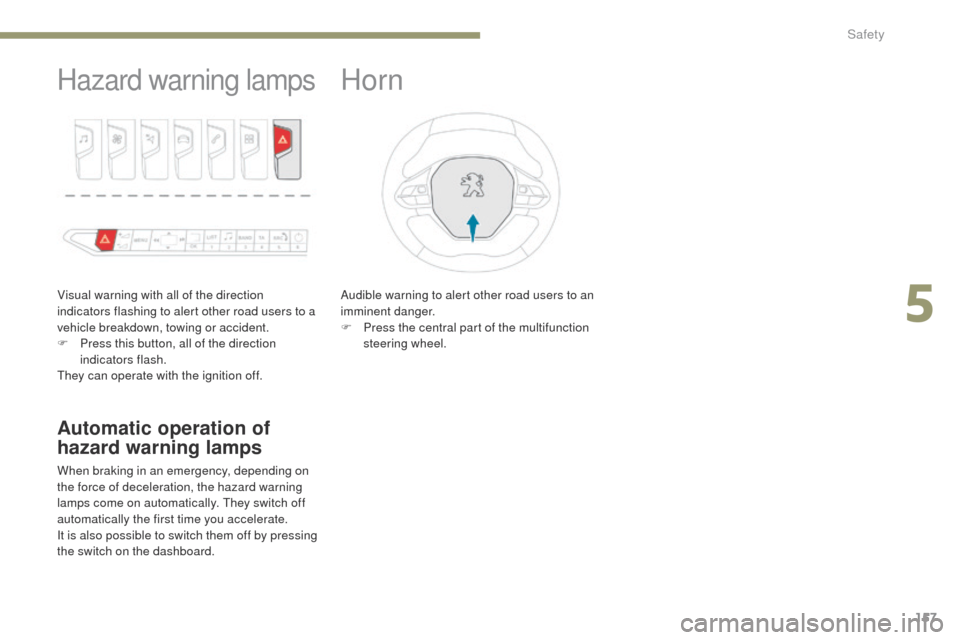
157
3008-2_en_Chap05_securite_ed01-2016
Hazard warning lamps
Visual warning with all of the direction
indicators flashing to alert other road users to a
vehicle breakdown, towing or accident.
F
P
ress this button, all of the direction
indicators flash.
They can operate with the ignition off.
Automatic operation of
hazard warning lamps
When braking in an emergency, depending on
the force of deceleration, the hazard warning
lamps come on automatically. They switch off
automatically the first time you accelerate.
It is also possible to switch them off by pressing
the switch on the dashboard.
Horn
Audible warning to alert other road users to an
imminent danger.
F
P
ress the central part of the multifunction
steering wheel.
5
Safety
Page 175 of 578
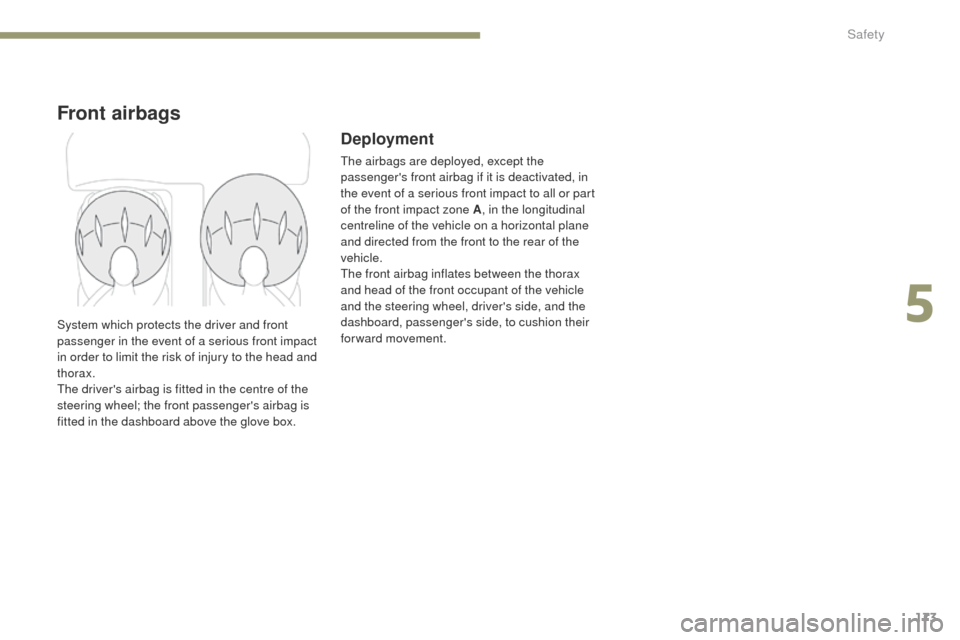
173
3008-2_en_Chap05_securite_ed01-2016
Front airbags
Deployment
The airbags are deployed, except the
passenger's front airbag if it is deactivated, in
the event of a serious front impact to all or part
of the front impact zone A, in the longitudinal
centreline of the vehicle on a horizontal plane
and directed from the front to the rear of the
vehicle.
The front airbag inflates between the thorax
and head of the front occupant of the vehicle
and the steering wheel, driver's side, and the
dashboard, passenger's side, to cushion their
for ward movement.
System which protects the driver and front
passenger in the event of a serious front impact
in order to limit the risk of injury to the head and
thorax.
The driver's airbag is fitted in the centre of the
steering wheel; the front passenger's airbag is
fitted in the dashboard above the glove box.
5
Safety
Page 178 of 578

176
3008-2_en_Chap05_securite_ed01-2016
Advice
Front airbags
Do not drive holding the steering wheel by its
spokes or resting your hands on the centre
part of the wheel.
Passengers must not place their feet on the
dashboard.
Do not smoke as deployment of the airbags
can cause burns or the risk of injury from a
cigarette or pipe.
Never remove or pierce the steering wheel or
hit it violently.
Do not fit or attach anything to the steering
wheel or dashboard, this could cause injuries
with deployment of the airbags.
Lateral airbags
Use only approved covers on the seats,
compatible with the deployment the lateral
airbags. For information on the range of seat
covers suitable for your vehicle, you can
contact a PEUGEOT dealer.
Do not fix or attach anything to the seat
backs (clothing...). This could cause injury
to the chest or arms if the lateral airbag is
deployed.
Do not sit with the upper part of the body any
nearer to the door than necessary.
Curtain airbags
Do not fix or attach anything to the roof. This
could cause injury to the head if the curtain
airbag is deployed.
If fitted on your vehicle, do not remove the
grab handles installed on the roof, they play
a part in securing the curtain airbags.
Sit in a normal upright position.
Wear a correctly adjusted seat belt.
Do not leave anything between the
occupants and the airbags (a child, pet,
object...), nor fix or attach anything close to
the inflation trajectory of the airbags; this
could cause injuries during their deployment.
Never modify the original definition of your
vehicle, particularly in the area directly
around the airbags.
After an accident or if the vehicle has been
stolen or broken into, have the airbag
systems checked.
All work on the airbag system must be
carried out by a PEUGEOT dealer or a
qualified workshop.
Even if all of the precautions mentioned
are observed, a risk of injury or of minor
burns to the head, chest or arms when an
airbag is deployed cannot be ruled out. The
bag inflates almost instantly (within a few
milliseconds) then deflates within the same
time discharging the hot gas via openings
provided for this purpose.
For the airbags to be fully effective, observe the safety recommendations below:
The vehicle's front door panels include side
impact sensors.
A damaged door or any unauthorised or
incorrectly executed work (modification or
repair) on the front doors or their interior trim
could compromise the operation of these
sensors - Risk of malfunction of the lateral
airbags!
Such work must only be done by a
PEUGEOT dealer or a qualified workshop.
Safety